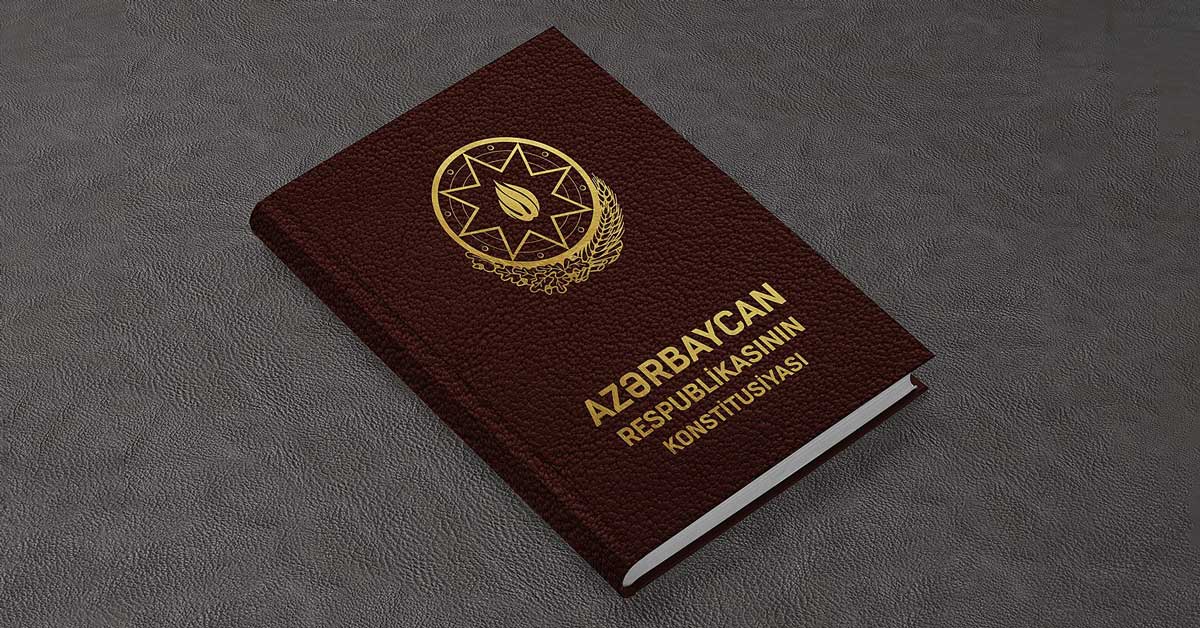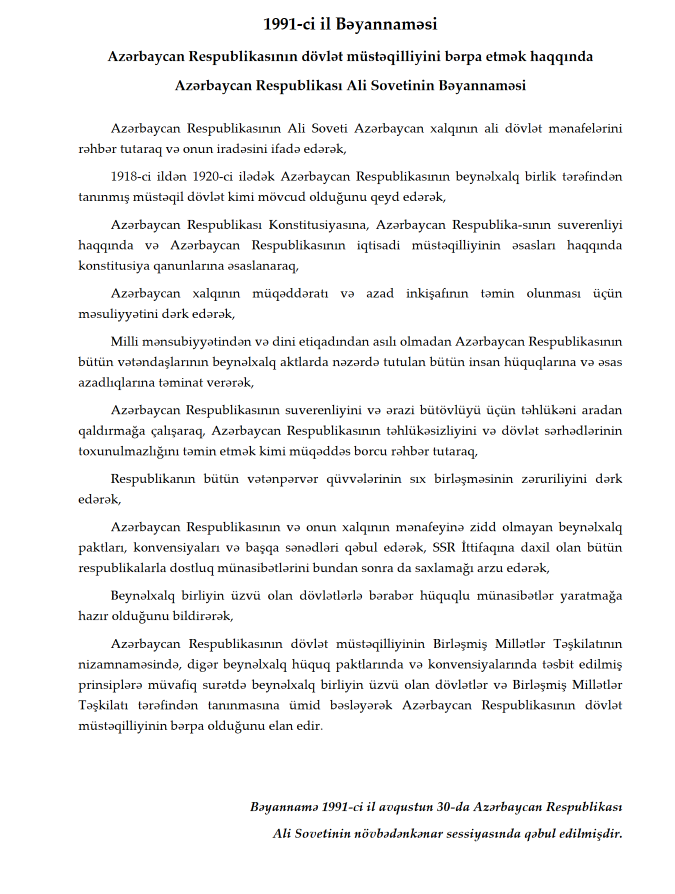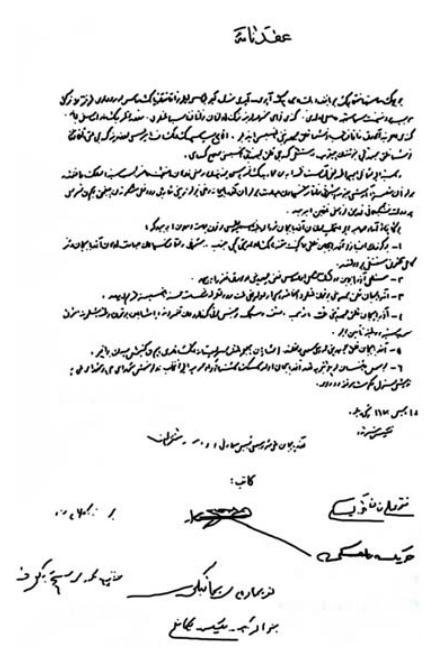Declaration of Independence of the Republic of Azerbaijan, 1918
2025
2025
2025-10-18

The Constitution of Azerbaijan and the legal documents related to its independence in 1991, indirectly defy the current territorial and border scope of Azerbaijan. The issue is multilayered and traces its roots back to 1918–1920.
The current constitution of the Republic of Azerbaijan was adopted through a nationwide referendum on November 12, 1995, and entered into force on November 27 of the same year. Despite amendments in 2002, 2009, and 2016, Azerbaijan’s fundamental law still contains quite problematic provisions concerning territorial and border issues—particularly regarding the legality of belonging of Nagorno-Karabakh and Nakhijevan to Azerbaijan.
The preamble of Azerbaijan’s Constitution states that it is based on the principles reflected in the constitutional act “On the State Independence of the Republic of Azerbaijan,” which was adopted by the Supreme Council of Azerbaijan on October 18, 1991. This act, in turn, derives from the declaration “On the Restoration of the State Independence of the Republic of Azerbaijan,” adopted at an extraordinary session of the Supreme Council on August 30, 1991.
The declaration “On the Restoration of the State Independence of the Republic of Azerbaijan” specifically states that the Republic of Azerbaijan of 1918–1920 existed as an independent state recognized by the international community.

Declaration “On the Restoration of the State Independence of the Republic of Azerbaijan,” 1991.
The issue of continuity with the Republic of Azerbaijan that existed in 1918–1920 is expressed more explicitly in the constitutional act derived from the declaration of independence.
According to the constitutional act
Why these provisions and, consequently, Azerbaijan’s Constitution, are problematic?
First, the Azerbaijan Democratic Republic of 1918–1920 did not have clearly defined or internationally recognized borders. The preamble of the constitutional act refers to the declaration of independence of May 28, 1918, whose first article states that Azerbaijan extends over Southern and Eastern Transcaucasia—a description that is highly vague and does not imply precise territorial boundaries.

The claim that the Azerbaijan Democratic Republic of 1918–1920 was internationally recognized, and therefore a subject of international law, is also unfounded. On January 11, 1920, the Paris Conference only recognized the existence of such a state de facto, which did not imply recognition of any borders. Specifically, in its January 10 communication, British foreign secretary Lord Curzon stated that the de facto recognition of the independence of Georgia and Azerbaijan did not include any decision regarding their present or future boundaries. Moreover, at the beginning of 1920, the League of Nations rejected Azerbaijan’s application for membership for two main reasons: “first, it was difficult to determine precisely the territory over which the government exercised its authority; and second, ongoing disputes with neighboring states made it impossible to define Azerbaijan’s current borders accurately.” Consequently, by denying the realities that existed from April 27–28, 1920 (after Sovietization) until August 30, 1991, including the borders formed during this period, the Republic of Azerbaijan “inherits” from 1918–1920 undefined borders and internationally unrecognized territory with disputed issues, since the internationally recognized borders of modern Azerbaijan were established during the Soviet period, particularly in 1921.
The formation of Soviet Azerbaijan’s borders mainly occurred in two significant phases: first, with the decision of the Plenum of the Caucasian Bureau of the RCP(b) on July 5, 1921, which transferred Nagorno-Karabakh to Azerbaijan (the borders of the NKAO and the Kurdistan Uyezd were only established on July 7, 1923); and second, through the Moscow Treaty of March 16, 1921, and the subsequent Treaty of Kars on October 13, 1921, which placed Nakhijevan under Azerbaijan’s protection as an autonomous republic. It should also be noted that these acts, the decision of the Caucasian Bureau Plenum as well as the Moscow and Kars treaties, contain serious legal violations from the perspective of legal legitimacy.
As of April 1920, there was no legal act confirming Nakhijevan’s belonging to Azerbaijan; on the contrary, as early as 1919, it was recognized as an integral part of the Republic of Armenia. If Nakhijevan had genuinely belonged to Azerbaijan in April 1920 and received international recognition, it would not have become the subject of a Russo-Turkish bargain and transferred to Azerbaijan under the condition that Azerbaijan will not relinquish it to any third party.
As for Nagorno-Karabakh, the local Armenian population, at the 7th Congress, had only conditionally and temporarily accepted Azerbaijani authority pending a final settlement by the Paris Peace Conference. Moreover, the issue of Karabakh as a disputed territory was mentioned in the League of Nations’ rejection of Azerbaijan’s application for membership. Consequently, there is no international or interstate legal regulation that would confirm Azerbaijan’s legitimate authority over Nagorno-Karabakh in 1918–1920. Had a logical resolution been reached on this issue before April 28, 1920, it would not have become a subject of intra-Bolshevik discussion in June–July 1921.
Thus, it must be stated that the documents and provisions claiming to provide a legal basis for Azerbaijan’s territorial extent challenge the historical and current legal-political belonging of both Nakhijevan and Nagorno-Karabakh to Azerbaijan.